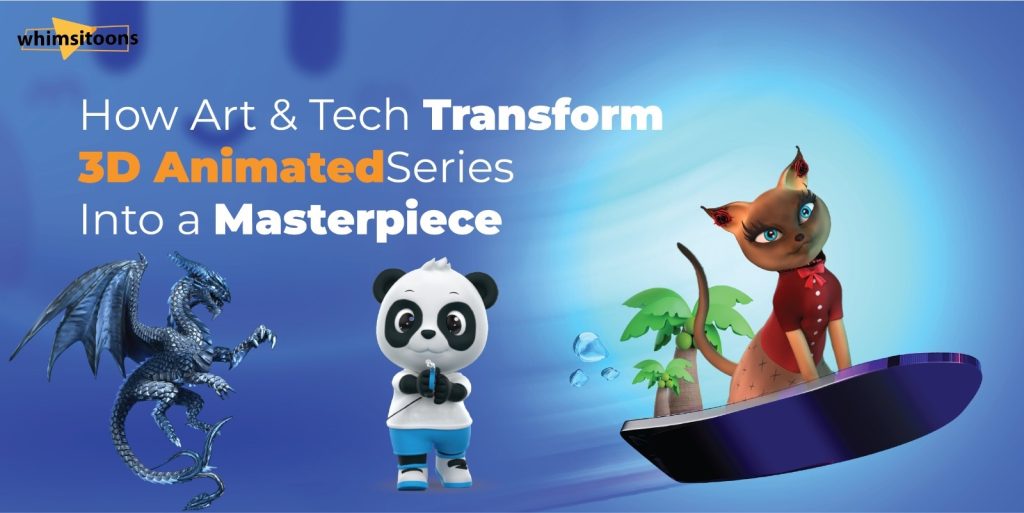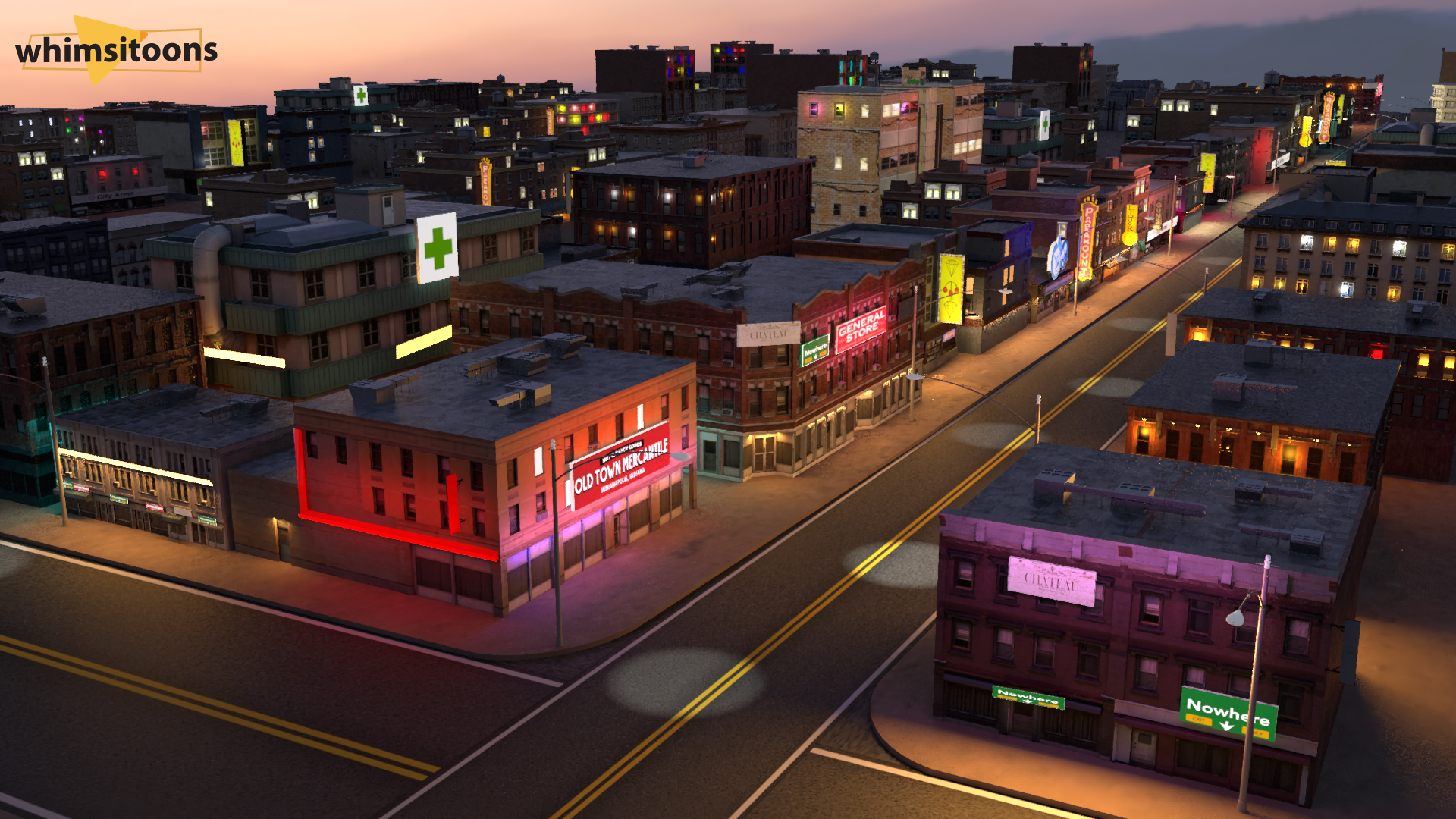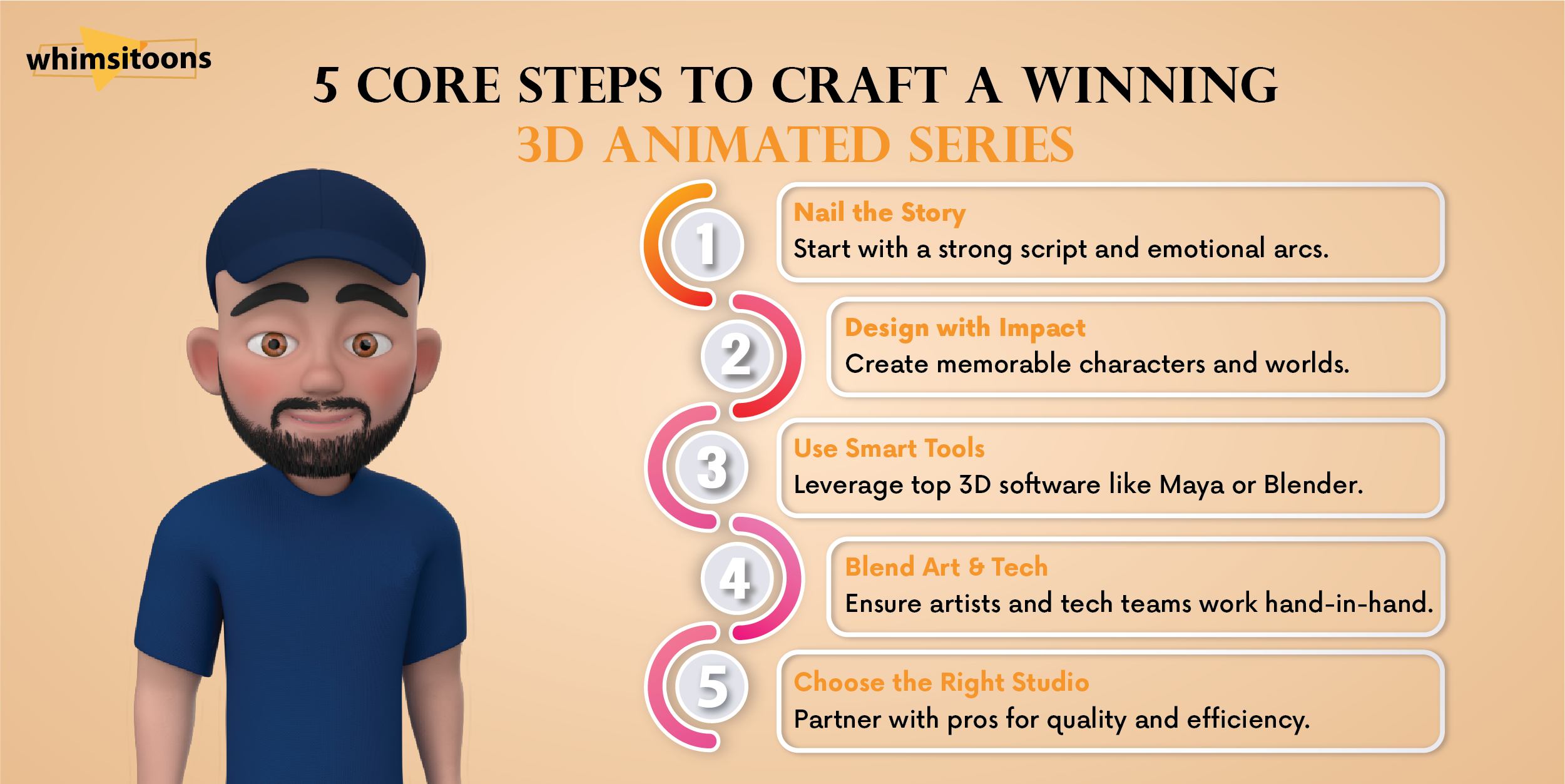How Art & Tech Transform 3D Animated Series Into a Masterpiece

|
Animation can explain whatever the mind of man can conceive. ~ Walt Disney |
Think Toy Story. Think Frozen. These 3D animated films didn’t just entertain; they made us feel.
We laughed, we cried, and we connected with characters who weren’t even human. Why?
Because they blended imaginative storytelling with cutting-edge technology to create powerful emotional experiences.
In a world where audiences scroll fast and forget faster, a good story isn’t enough.
You need rich visuals, emotional depth, and content that instantly grabs attention and holds it.
That’s the true power of 3D animation when done right.
In this blog, you’ll learn how the right mix of creativity and technology can turn your idea into a compelling 3D cartoon series, and why choosing the right experts makes all the difference.
Key Takeaways
- Good 3D animated series have strong storytelling that drives character arcs and visual flow.
- Everything from character design to environments affects emotion and narrative.
- Turning ideas into high-quality, visually striking content that connects requires the right animation studio.
What Are 3D Animated Series?
A 3D animated series consists of a collection of animated episodes that utilize computer-generated images (CGI) to create characters, virtual environments, and movements.
This technology lets you add a lot of detail and depth, which makes these series more compelling and realistic than regular digital animation.
Understanding the Significance of 3D Animated Series
These 3D animated TV shows are crucial in the world of animation because they allow for endless creative options and improve the depth of the images.
With characters that look and move like real people, realistic textures, and fluid movements, 3D animation brings worlds to life.
This technology gives creators the freedom and detail they need to take visual storytelling to new heights.
Examples of Iconic 3D Animated Series
Pixar’s 3D animated series Toy Story, the first fully 3D-animated feature film, was released in 1995.
It showed the power of computer-generated imagery (CGI) in storytelling and proved that 3D animation could produce deep emotions and visually rich scenes.
What set Toy Story apart was its stunning detail and realism.
From the fabric of Woody’s clothes to the sheen of Buzz’s suit, every detail of characters like them was expertly crafted with realistic textures.
Below are a few more 3D animated series lists featuring some of the most loved series.
These series demonstrate the power of 3D animation to forge emotional bonds with audiences, all while showcasing remarkable technical expertise.
Why Creativity and Technology Are Essential for a Great Animated Series
Creating a 3D animated series is a delicate balance of creativity and technology.
Without creativity, even the best tools would be useless, and without the right technology, the animation would fall short of its potential.
- Creativity in animation drives character design, storytelling, and visual style.
- Technology allows animators to build complex worlds and seamlessly integrate every visual element.
The Role of Creativity in Shaping a Series
Creativity is what sets 3D animated series apart from the rest.
From designing unique characters and environments to developing a compelling storyline, creativity is the backbone of any successful 3D animation show.
Here’s how creativity shapes the process:
-
Character Development in 3D Animation
In 3D animation, characters are the emotional core of the story.
The development of these characters involves more than just giving them physical features.
3D character designers must use creativity to make these traits instantly recognizable.
For example,
|
Elsa from the animated film Frozen: her poised posture, cool-toned palette, and changing costume symbolize her transformation from self-discovery to self-acceptance. |
These design choices were made on purpose.
Every element is designed with the goal that 3D character animation and the character’s purpose and personality are immediately apparent.
-
Creative Process Behind 3D Animation Environments
 When it comes to 3D animation, characters, their faces, voices, and storylines often get all the attention.
When it comes to 3D animation, characters, their faces, voices, and storylines often get all the attention.
But behind the scenes, the environment plays an equally vital role.
Think about it:
- Would a heroic moment have the same impact without the soaring landscape behind it?
- Can a villain’s home be as intimidating without shadows, scale, or mood? Probably not.
Because environments set the stage and intensify the story’s emotional power.
Designers start by figuring out the tone and emotions of the story.
They then work on every detail, from the structure and lighting to the textures, to create immersive worlds that support the story and the characters’ actions.
-
Artistic Direction of Storytelling & Storyboarding
A good story is the most important part of any great 3D cartoon series.
A movie’s script is the creative blueprint for everything on screen. It sets the tone, structure, pacing, and dialogue. Without it, even the most stunning visuals fall short.
Writers don’t just make scenes; they also create emotional journeys, define characters, and shape whole worlds.
Example of best storytelling:
|
The story begins with a young child preparing for a big move, and it takes us inside her head as Joy, Sadness, and other emotions try to keep her in balance. At first, it seems like a fun and creative story, but it quickly turns into a touching story about growing up, letting go, and learning that it’s okay to feel everything. |
That is the magic of a well-told story; it sets the stage for good storyboarding by giving artists a clear picture of how to plan scenes, emotions, and pacing with purpose and accuracy.
The Technological Foundations of 3D Animation
Without the right technology, no matter how creative the ideas, the project won’t come to life the way it should.
In the world of 3D animation, several key technologies are used:
-
3D Modeling:
The first step involves creating the assets that will populate the animated world.
Animation tools like Maya, Blender, or 3Ds Max help create detailed models of characters, objects, and environments.
-
Rigging and Animation:
Rigging allows characters to move and express emotion, while animation software breathes life into these rigs, creating fluid motion.
-
Rendering:
Rendering turns the 3D models into fully realized images or frames, often requiring high-level computing power for realistic results.
The right combination of these technologies ensures that the 3D animated series is not only visually stunning but also able to maintain consistent quality across episodes.
How Art and Tech Collaborate to Create a Stunning Animated 3D Shows
The true magic of 3D animation happens when art and technology collaborate seamlessly.
This collaboration begins in the early stages of concept design and continues all the way to the final rendering.
Here’s how it works:
-
Art drives direction:
The artist’s ideas about the characters, scenes, and world shape the whole animation.
Artists work with animators and tech experts to make sure their ideas come to life exactly as they’ve imagined!
-
Technology supports creativity:
Tools and software give animators the support they need to bring their creative ideas to life, whether they’re making complicated VFX (visual effects) or high-quality 3D cartoon animation.
When both elements work hand-in-hand, the outcome is a 3D animated series that portrays quality while showcasing technical expertise.
How the Right Technology Brings Your Animated Series Vision to Life
The right technology does more than just produce high-quality visuals.
It is about helping the creative team to efficiently bring their vision to life.
It is possible to make complex, lifelike movements and realistic environments with real-time rendering software, advanced compositing techniques, keyframe animation, and motion capture.
By using the most up-to-date technology:
- Animators can create complex scenes that would be impossible with traditional methods.
- Artists can manipulate lighting, textures, and colors to enhance the mood and atmosphere of every scene.
- Animation studios can streamline production timelines, ensuring that projects are delivered on time without sacrificing quality.
Why the Right Animation Studio is Crucial for Your Animated Series
When creating an animated series in 3D, the studio you choose plays a critical role in bringing the project to life.
A professional studio contributes both artistic expertise and technical skill, guaranteeing the full potential of your series.
Working with a reputable studio offers several benefits:
- Expertise in both art and tech: The best studios have experienced teams that can balance creativity and technology seamlessly.
- Efficient project management: Professional 3D animation service providers ensure meeting deadlines and allocating resources effectively.
- Consistency and quality: Top-tier studios are committed to maintaining high standards across all episodes, ensuring that every part of the series meets your expectations.
 Creative vs. Technical Roles in 3D Animation Production
Creative vs. Technical Roles in 3D Animation Production
|
Role |
Creative Tasks |
Technical Tasks |
|
Art Director |
Defines visual style |
Oversees tool compatibility & pipeline |
|
Storyboard Artist |
Sketches, scenes & transitions |
Syncs with pre-vis and animatics |
|
Character Designer |
Designs, looks, costumes, and personality |
Works within 3D model mesh limits |
|
Animator |
Craft character movement & expressions |
Uses rigging systems for fluid motion |
|
Technical Director |
N/A (support role) |
Solves rendering, pipeline, & rigging issues |
Things to Consider Before Starting Your 3D Animated Series
Before diving into production, keep these key points in mind:
- Audience First: Who are you trying to reach? Are they kids, teens, families, or adults? It affects the style and tone.
- Budget vs. Vision: 3D animation of high quality costs money and takes time, so make sure your expectations match your budget.
- Scalability: Planning a series? Build a consistent design system to scale your characters and environments over episodes.
Conclusion
Creating a 3D animated series is a difficult and time-consuming process that requires a keen eye for detail.
From the initial concept art to the stunning final render, each phase hinges on the ideal blend of creativity and technology.
By partnering with an experienced animation studio, you can bring your vision to life and create a series that not only stands out visually but also resonates with your audience.
FAQs
Q 1: What is the difference between 2D and 3D animated series?
2D animation uses flat, hand-drawn or digitally drawn characters and environments, giving a more stylized, traditional look. In contrast, 3D animation creates characters and worlds in three-dimensional space, allowing for realistic depth, movement, and lighting, like what you see in Frozen or Toy Story.
Q 2: How do 3D animated series differ from CGI series?
3D animation refers to the technique of animating characters in a 3D space. CGI (Computer-Generated Imagery) is the broader term that covers all computer-created visuals, including 3D animation. So, all 3D animation is CGI, but not all CGI is 3D animation.
Q 3: What is a 3D animated series?
A 3D animated series uses digital characters and environments to bring them to life. This method allows the story more realistic depth, movement, and detail, which enhances its visual dynamic and immersion.
Q 4: What is a 3D cartoon animated series?
A 3D animated cartoon combines the charm of traditional cartoons with modern animation technology to produce vibrant, lively characters and environments.
Q 5: How is a 3D animation show different from traditional animation?
A 3D animation show uses computer software to bring characters and scenes to life with realistic depth and supple movement, as opposed to traditional 2D animation, which is flat, hand-drawn, or digitally drawn frame-by-frame.










